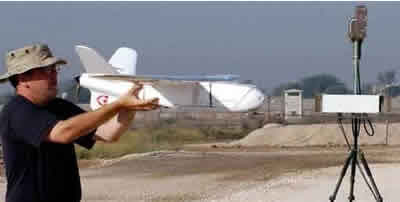Flying Robot Officers? Don't Ask, Don't Tell.
According to strategypage.com the US Air Force faced a bit of a quandry when it started using more of the FPASS (Force Protection Airborne Surveillance System) Desert Hawk flying robots.
Since World War II the Air Force has required pilots to be officers with a college education.
This requirement has applied equally to "flying" the larger UAV flying robots.
But the Desert Hawk is 32 inches long with a 52 inch wingspan. It is basically a souped-up hobby plane. (A very expensive one at $300,000 per system)

The Air Force required that the UAV's be made completely autonomous so that they would not have to spare so many officers to fly them. Today the unit, with on-board cameras and GPS navigation, is pre-programmed and let go. The ground crew, which launches the robot with a bungee chord, monitors the craft but technically does not 'pilot' it.
News about Air Force at StrategyPage.com's How to Make War.
Since World War II the Air Force has required pilots to be officers with a college education.
This requirement has applied equally to "flying" the larger UAV flying robots.
But the Desert Hawk is 32 inches long with a 52 inch wingspan. It is basically a souped-up hobby plane. (A very expensive one at $300,000 per system)

The Air Force required that the UAV's be made completely autonomous so that they would not have to spare so many officers to fly them. Today the unit, with on-board cameras and GPS navigation, is pre-programmed and let go. The ground crew, which launches the robot with a bungee chord, monitors the craft but technically does not 'pilot' it.
News about Air Force at StrategyPage.com's How to Make War.

1 Comments:
$300K seems awful steep for a fancy model airplane. I bet mythbusters could make one with off the shelf parts for less than $3000.
Post a Comment
Subscribe to Post Comments [Atom]
<< Home